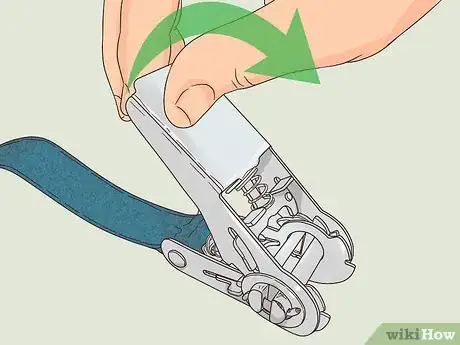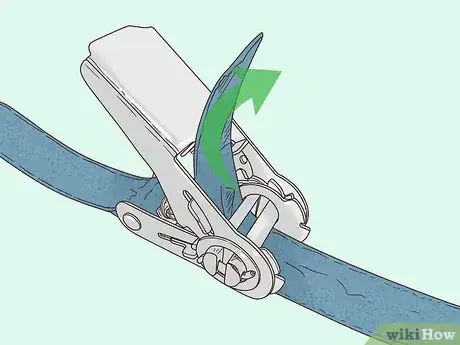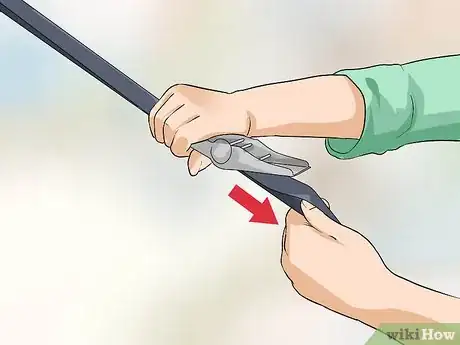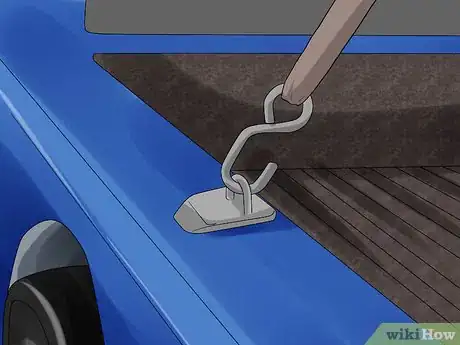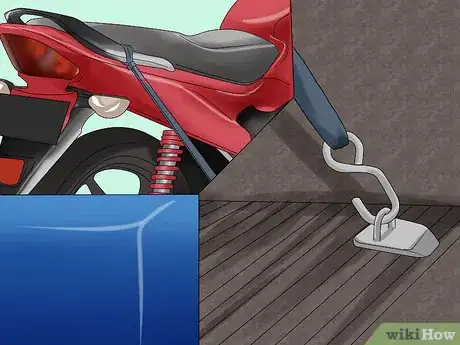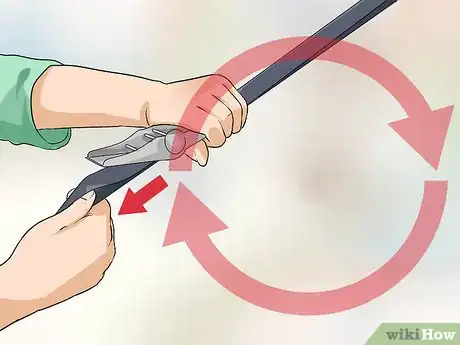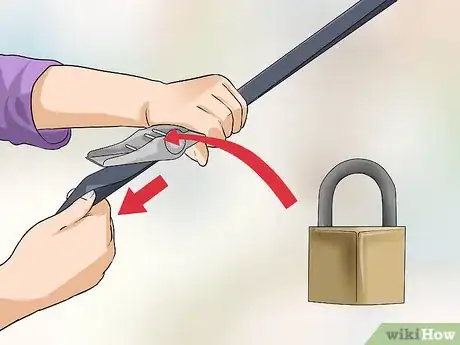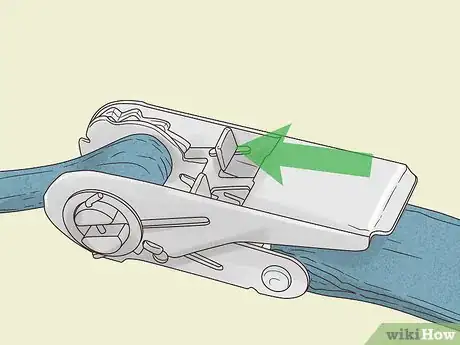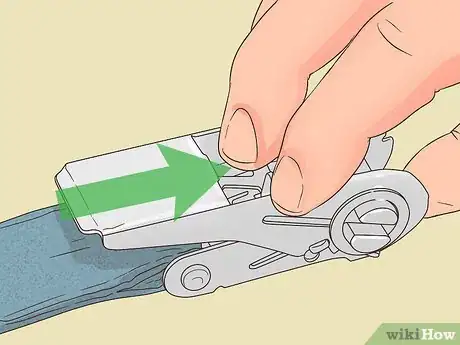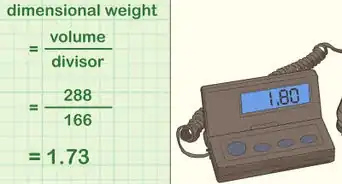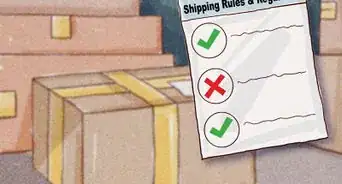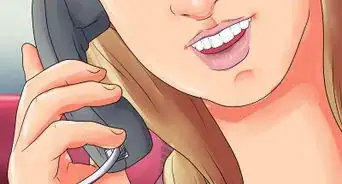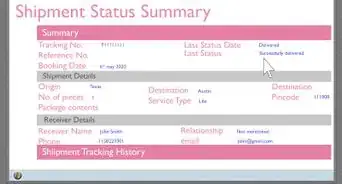This article was co-authored by wikiHow Staff. Our trained team of editors and researchers validate articles for accuracy and comprehensiveness. wikiHow's Content Management Team carefully monitors the work from our editorial staff to ensure that each article is backed by trusted research and meets our high quality standards.
This article has been viewed 846,761 times.
Learn more...
Ratchet straps are fasteners used to secure cargo during transport. When used correctly, these straps can support many different weights and cargo sizes. In order to properly use your ratchet straps, thread the strap through the mandrel and then crank the ratchet to tighten it. To release the strap, press the release tab and open the ratchet.
Steps
Threading a Ratchet Strap
-
1Use the release catch to open the ratchet. The release catch, also known as the release lever, is a smaller handle that disengages the ratcheting handle. It’s located in the center of the top movable piece of the ratchet. Pull up the release catch and flip the ratchet fully open. Set the open ratchet on a table before you so that the spiked wheels (cogs) are facing upwards.[1]
-
2Thread the strap through the bottom of the ratchet. The slot at the bottom of the ratchet, known as the “mandrel,” holds the length of the strap. To thread the strap, start from underneath the ratchet and push it up through the mandrel. The threaded strap should then lay straight, the length of it overlapping with the second strap on the other side of the ratchet.Advertisement
-
3Continue feeding the strap through the mandrel until it feels taut. Remember that you can always tighten it with the ratchet later, so don’t worry too much about the length.[2]
Securing Your Cargo
-
1Secure cargo in a vehicle with the strap hooks. Ratchet straps can easily secure cargo in a truck bed or moving van. Move your cargo where you want it to stay, then place the ratchet strap across your cargo. Hook the ends over the side of the truck bed or in grooves in the van wall.[3]
-
2Hook the ends around the item to hold pieces together. If you’re using the ratchet strap to hold several objects together, such as 2 large frames, wrap the strap around those objects and simply hook the 2 ends together. This will create a large, secure loop.
- Keep in mind that this technique will hold objects together, but will not keep them in place.
- To hold multiple objects together and keep them in place, you’ll need two ratchet straps. Use one strap to secure the objects together and the other strap to wrap around them and strap them into place.
-
3Crank the ratchet until it feels secure. Pull the ratchet back and forth to pull the length of the strap through and tighten it. Once it feels taut and secure around your cargo, stop ratcheting. Tug at the strap and check for give--it should feel tight and secure.[4]
- Be careful not to over-tighten. Too much pressure could damage your ratchet strap or your cargo.
- If you can’t fit a finger between the strap and the object, you probably overtightened. Loosen the strap and ratchet it closed again.
-
4Lock the strap securely. Flip the ratchet back into the closed position. Press it closed until you hear it latch. This means that the strap is locked into place and should hold your cargo securely.
- If you don’t hear the click, tug on the strap and buckle to make sure it’s secure. If it comes loose, you may have a faulty ratchet strap.
Releasing the Strap
-
1Pull and hold the release tab. This will override the ratcheting function and release the lock. The release tab should be easy to access and located on the top of the ratchet.[5]
- If you can’t locate the release tab, check your operation instruction manual.
-
2Open up the ratchet and pull the strap loose. Flip the ratchet completely open so it lays flat, then pull on the non-fixed side of the strap. This will release the strap from the ratchet’s hold and allow you to completely remove the strap.[6]
-
3Pull and hold the release tab to close the ratchet again. Locate the release tab once again and hold it down while you flip the ratchet closed. This will keep the ratchet in locked position until it is ready to be used to again.[7]
Warnings
- Always inspect the straps for signs of wear before using them. Do not use a strap that has fraying, abrasive wear, broken or worn-down stitching, tears, cuts, or defective hardware.⧼thumbs_response⧽
References
- ↑ https://www.youtube.com/watch?v=eTD0M0kQ2kY
- ↑ https://www.youtube.com/watch?v=eTD0M0kQ2kY
- ↑ https://www.youtube.com/watch?v=eTD0M0kQ2kY
- ↑ https://www.youtube.com/watch?v=eTD0M0kQ2kY
- ↑ http://www.ratchetstraps.info/ratchet-strap-instructions
- ↑ http://www.ratchetstraps.info/ratchet-strap-instructions
- ↑ http://www.ratchetstraps.info/ratchet-strap-instructions
- ↑ https://www.youtube.com/watch?v=9mFX3Ezdkfw
- ↑ http://knowhow.napaonline.com/tips-use-ratchet-straps/
About This Article
To use ratchet straps, start by using the release catch to open the ratchet, then thread the strap through the bottom of the ratchet until it feels taut. Next, place the ratchet strap across your cargo and hook the ends over the side of the truck bed to secure the cargo in place. Then, pull the ratchet back and forth to tighten the strap. Once it feels taut and secure around your cargo, stop ratcheting and lock the strap securely! For tips on using ratchet straps to secure to large items together, read on!
